Metamask: The Leading Non-Custodial Wallet
In this section, I’m going to explain what MetaMask is!
MetaMask is arguably one of the best quality-of-life innovations in online shopping is automated checkouts. You simply enter your PayPal or debit card information once, and the next time you purchase something from the website, all you need to do is click one button, and all of the money transaction processes happen for you.
Essentially, this is how MetaMask functions in the cryptocurrency world, as well.
In this section, we’re going to check out what is MetaMask. We’ll also answer questions such as “is MetaMask safe?”, and how you can use this crypto software platform in your daily life.
Let’s get right to it, shall we?

Video Explainer
Video Explainer: Metamask: The Leading Non-Custodial Wallet
Reading is not your thing? Watch the "Metamask: The Leading Non-Custodial Wallet" video explainer
What is a MetaMask Wallet? (And How to Use it - Animated)


What is MetaMask?
First things first - what is MetaMask?
Well, MetaMask is an internet app that serves a few different purposes. The primary (and most well-known) purpose is cryptocurrency storage - in other words, MetaMask is a “crypto wallet”, or actually a HOT crypto wallet!
Why “hot”, though?
Simply, in crypto, all software-based wallets are called “hot wallets”, and as an opposite, all electronic hardware-based wallets are called “cold wallets”.
So, first and foremost, the MetaMask app is a software wallet!
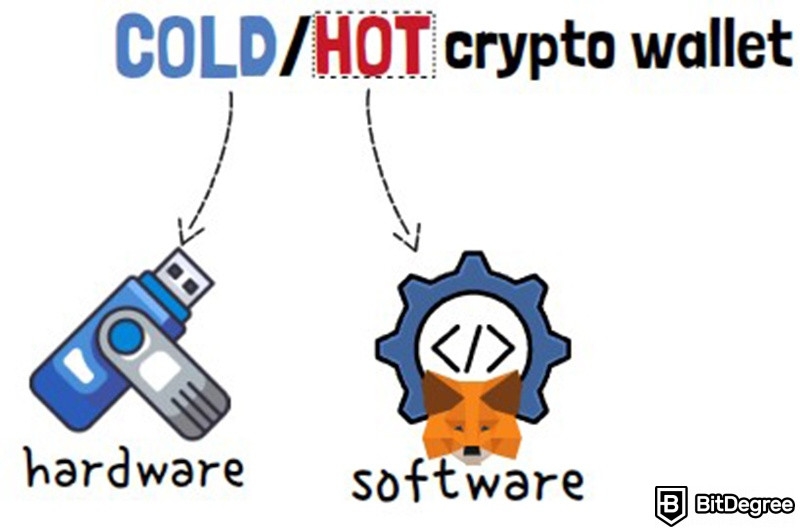
Let’s break the concept of a crypto wallet down.
A cryptocurrency wallet is a digital equivalent of your physical wallet. Just as you hold your real money in your physical wallet, cryptocurrency wallets hold your digital coins - cryptocurrencies such as Bitcoin, Ethereum, and many more.
Some wallets can only hold one coin, and are thus “dedicated”. For example, a Bitcoin-dedicated wallet would only be able to hold BTC coins. Others have the ability to hold multiple crypto coins - it depends!
MetaMask, however, is a dedicated wallet - it only allows you to hold everything that is related to the Ethereum blockchain: Ethereum coins, and any other ETH-based tokens. Check out the section called "Coins VS Tokens" to understand the differences and how they are related.
But shortly, cryptocurrency tokens are projects built on the blockchain of a specific coin - in this case, Ethereum. It’s a bit more complex and technical than that, but that's the premise. But what you should clearly understand is that you can’t store your Bitcoins on Metamask, but you can store any token that is built on the Ethereum blockchain, for example, Tether, Shiba Inu, Axie Infinity, and similar.
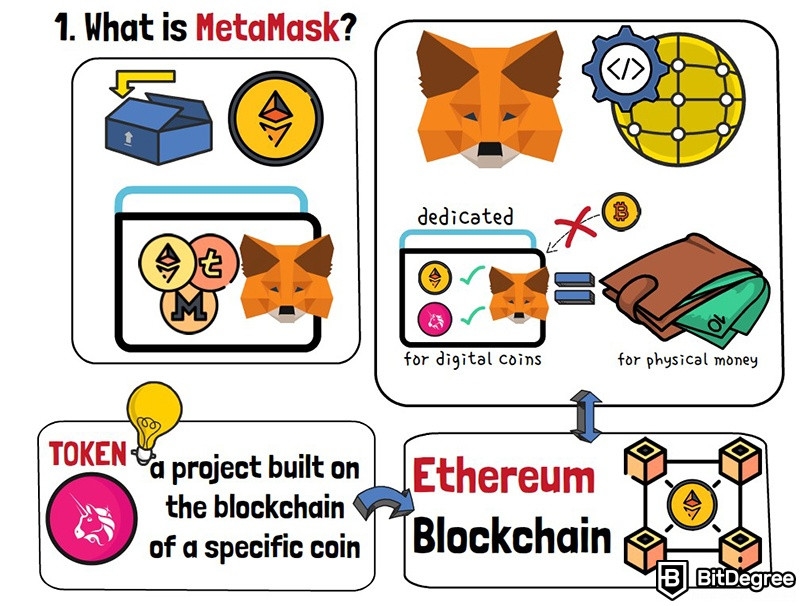
Here is an example: imagine that you’ve decided to go and wash your car. You approach a car washing station and have to insert coins in order for the machines to start working. However, the car wash only accepts US dollar coins, and any other foreign currencies, like Euros or Pounds Sterling get rejected!
The same logic applies to MetaMask - it only accepts Ethereum, and tokens that are built on the Ethereum blockchain.
What about the “hot” wallet part, though - how is it HOT, in the first place?
In the cryptocurrency world, “hot” wallets are those that maintain a constant connection to the internet. This means that, in order to use MetaMask, you will need to always be connected to the internet, and have access to the browser (or device) that the wallet is installed on. Yes, MetaMask acts both as a browser extension, and a mobile app.
Specifically, in the same manner, as how you would add apps such as Grammarly or adBlock to your browser, as a web extension, MetaMask will need to be added, as well. Or it can be downloaded from either the Android or the iOS stores.
So - it’s clear that MetaMask is primarily used as an Ethereum wallet. However, as you might have heard, it’s actually considered to be the most popular ETH wallet out there, in general! MetaMask has managed to achieve this by offering its users ease of use.
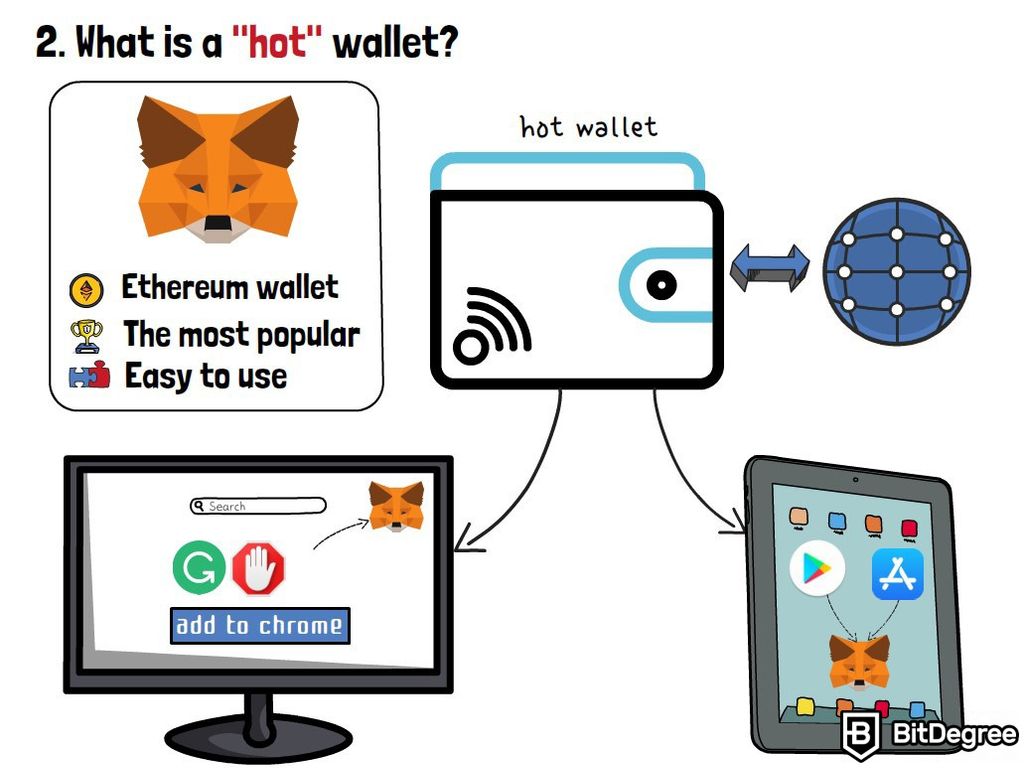
To be more specific, MetaMask allows you to perform cryptocurrency transactions (Ethereum payments or transfers) in a super-simple manner. You can even buy crypto tokens from an integrated third party, without leaving your MetaMask wallet, with the company taking a small cut as a transaction fee (this is how MetaMask makes money, too)!
Think of the earlier-discussed PayPal example - now, imagine PayPal integrated into your browser!
No matter where you go online, if you’d like to purchase something, all that you’d need to do is enter your password, and that’s it - you'll be able to pay for your order in a matter of seconds! MetaMask works in a similar manner - integrated into your browser, it allows you to access your Ethereum or ETH tokens in just a few clicks. You can also pay, send, or exchange ETH with anyone you’d like.
Is MetaMask Safe?
So - MetaMask is very convenient to use, as a cryptocurrency wallet. We’ve established that much already! However, naturally, you might question - is it reliable and safe to use, in the first place?
The short answer is YES, it is. Let’s expand on it, though, shall we?
MetaMask provides encryption and security technology and acts as the middleman between the user, and the service that they are accessing. In other words, MetaMask can be seen as the bridge between two parties - a bridge that’s full of security patrols, cameras, and guard posts.
Before we continue, I urge you to, once again, think about the PayPal example we’ve used a couple of times in this section already. PayPal encrypts your data, and protects all of your financial information - your money is only sent to those shops and service providers that you approve, manually.
In essence, MetaMask is the same. As a wallet, it protects your funds but still allows you to access them in a quick and effortless manner, when you need to.
All of that being said, I do have to point out that, all things considered, it IS a hot wallet - one that maintains a constant connection to the internet. In turn, this does open up doors for vulnerabilities.
Being connected to the web all the time, hot wallets are more prone to break-ins and hacking attempts, as opposed to cold wallets, or hardware devices. These are special devices that usually look like a USB drive, but are designated for storing and keeping your cryptocurrencies safe, offline.
Hot wallets, in general, aren’t the safest choice, when it comes to storing cryptocurrencies. However, they are very convenient, and require less time and effort to use, when compared to hardware devices!

An example that you can imagine is that of a car. Cars can be dangerous - something can go wrong with the engine, or you might get a flat tire mid-journey, and swirl into a ditch. On top of that, you always need to keep an eye on other drivers on the road, lest they would decide to drive into you.
That said, many people choose to drive cars, nonetheless. This is because the risk level is rather mediocre, especially if you take all of the active precautions beforehand - don’t go over the speed limit, wear your seatbelt, and so on.
The same can be said about hot wallets such as MetaMask, too. If you don’t visit shady websites or press suspicious links, and avoid any potential scams or strange individuals offering to double your crypto if you send it to them, you will minimize the risks, too!
How to Use MetaMask?
Up to this point, we’ve covered what is MetaMask, and the question of whether or not it’s safe to use. Now, let’s take a look at how you can actually start using the cryptocurrency wallet in question!
Since simplicity is key with MetaMask, installing the wallet isn’t a difficult process, either. Just 3 steps and you’re done!
All that you need to do is go to MetaMask.io, the official website. By the way, don’t fall for other scammy websites impersonating the real MetaMask wallet, and always check the URL in your browser for any possible spelling errors while visiting their website! It is kind of a usual fraudster’s practice, to fake an official domain, so be aware!
So next, depending on the device that you might be using, you will be able to download the official Metamask wallet as a browser extension, or as an app for Android or iOS mobile devices.
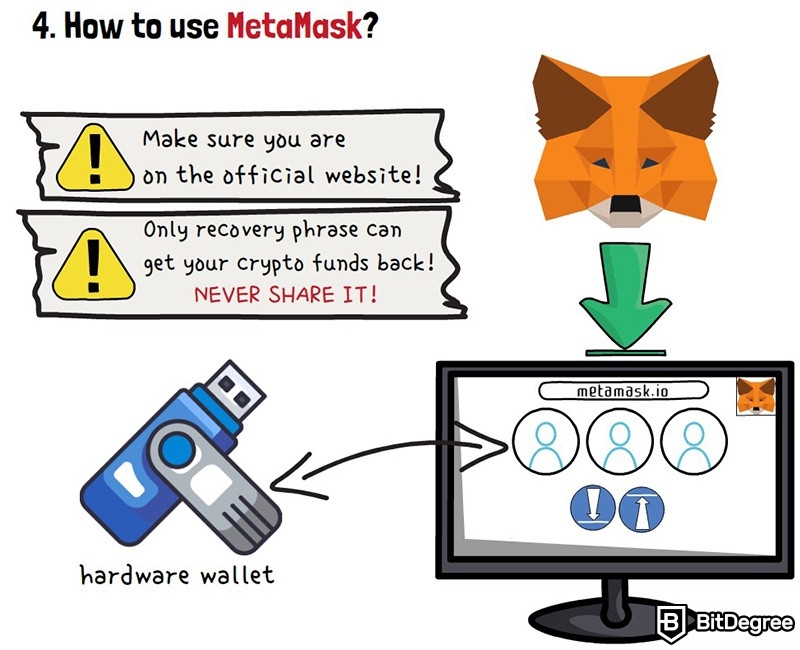
Once it’s installed, you’ll need to set up the wallet itself. While setting up, the most important part is the recovery phrase! Save it securely when prompted. I just want to emphasize here that the recovery phrase is the only tool that you’ll have in order to get your crypto funds back if you lose access to your wallet (for example, your computer gets damaged, or you lose your phone). Never ever share it with anybody for any reason!
Once all of that is done, that’s it - you can start sending and receiving Ethereum and its tokens from and to your MetaMask account!
One handy feature is that MetaMask also allows you to create multiple wallet accounts within the same app, if you so wish to, and even connect your hardware wallet to one of those accounts, for extra added security. This is like taking a safe full of money, and concreting it underground - it will increase the safety and security of your assets exponentially!
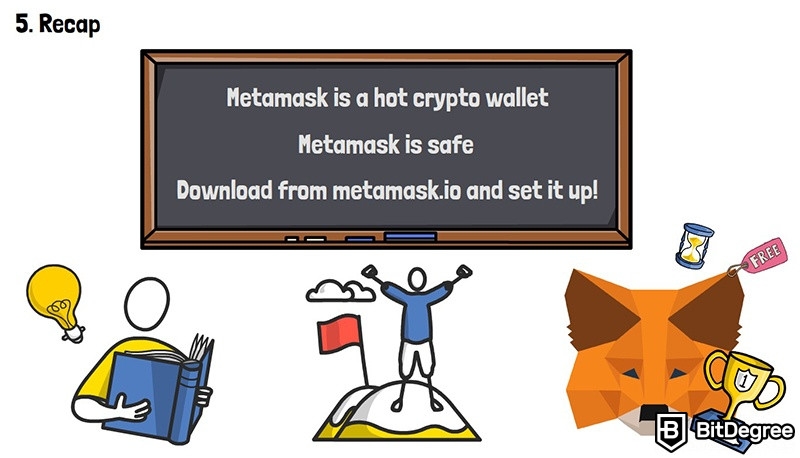
So, in this section, we’ve covered what MetaMask is, whether or not it’s a safe wallet to use, and how you can start using it, yourself. Being one of the most popular Ethereum wallets out there, it’s definitely worth learning about the platform, even if you don’t plan on using it, personally. And finally, I really encourage you just to go and try it yourself, it costs nothing and will take you a minute. But overall you’ll learn through experiencing it yourself!
That being said, I hope this section was helpful to you and you can also check out another topic such as "What are Smart Contracts?".










